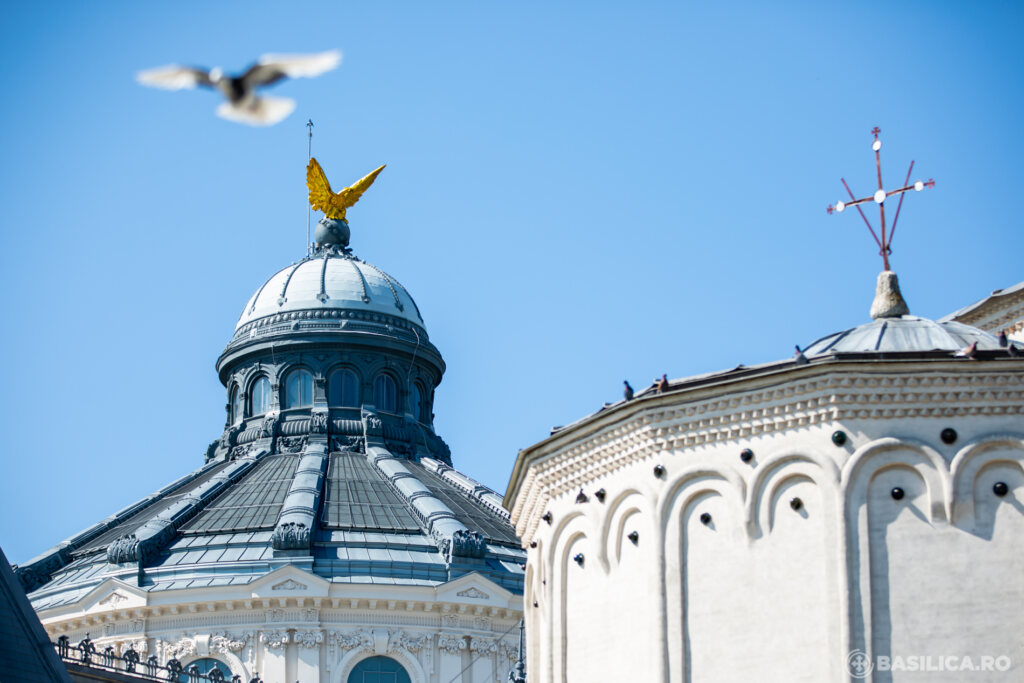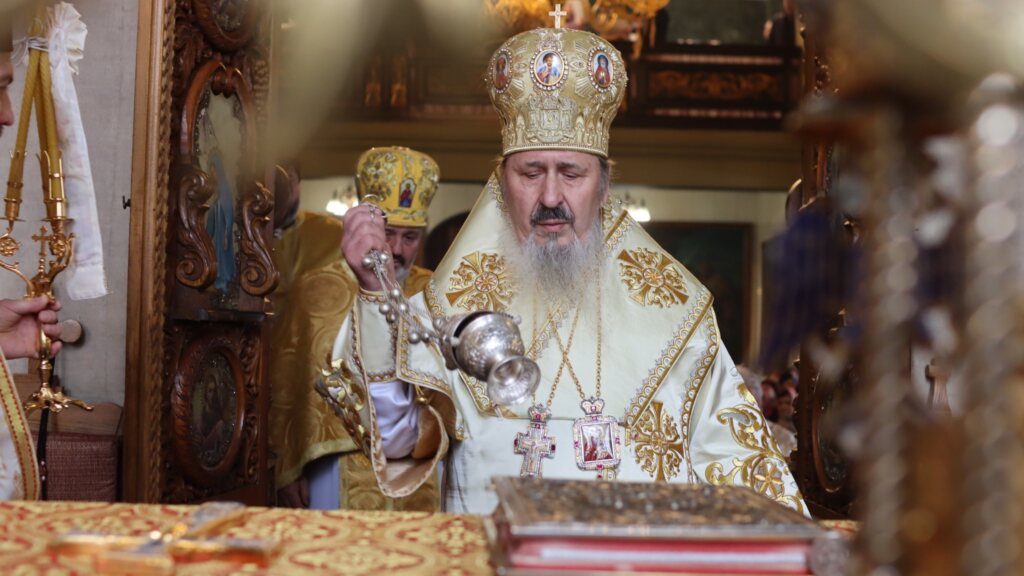Orthodox Calendar, April 24
Saint Iorest the Confessor
Saint Iorest the Confessor was born into a peasant family of Transylvania and received the name Elias in Baptism. He entered the Putna Monastery at an early age and was tonsured with the name Iorest. He made great progress in his spiritual life and was also a calligrapher and an iconographer. Because of his virtuous life, the hegumen of the monastery recommended him to be ordained to the holy priesthood.
Saint Iorest served the altar with great compunction and fear of God, edifying others with his sermons. In 1640, Prince Basil Lupu of Moldavia proposed Saint Iorest to succeed Metropolitan Gennadius of Ardeal, who had reposed. By God’s will, Saint Iorest was chosen to lead the church in Transylvania and was enthroned as Metropolitan in 1641.
For three years, the holy archpastor defended his flock from the snares of the devil and the false teachings of the Calvinists. He travelled throughout his diocese, appointing priests, consecrating churches, and teaching the people. Saint Iorest was thrown into prison in 1643 because of his zealous opposition to the activities of foreign missionaries who wished to convert the Orthodox faithful.
For nine months, he endured beatings and abuse. Then he was released and ordered to pay a fine. Saint Iorest returned to Moldavia in 1656-1657 and was appointed Bishop of Hushi. Here too, he served the Church well, labouring for the salvation of the flock God entrusted to him. The Lord called Saint Iorest to himself on April 24, 1657.
Saint Simeon Stephan
Saint Simeon Stephan – baptised Simeon and received the name of Stephan as a monk, was a hieromonk at a monastery in Alba Iulia, ascended on the episcopal throne in 1643, after Saint Elijah Iorest, in hard times for the Orthodox Church and the Transylvanian faithful, under rulers foreign to the nation and faith. Just like his predecessors, Saint Simeon Stephan was not spared troubles caused, especially by Prince Gheorghe Rakotzi and by Superintendent Gheleji, the leader of the Calvinists.
Having taken up his fatherly right to look after his spiritual sons and put them under his obedience by force, the Calvinist superintendent declared himself the master of the Romanian Church, which he wanted to rule and judge according to his own will.
Then, as if that was not enough, the Calvinist prince and superintendent imposed even harder and humiliating duties on the shoulders of the hierarch: to give up the teaching of the Holy Fathers of the Church, to teach the young people the Calvinist Catechism, not to confess the truth on the transforming of the Gifts into the Body and Blood of Christ at the Divine Liturgy.
Because they hated the icons, they urged him to take them and the Cross out of the churches. But the hierarch illuminated by God did not obey them but defended the Orthodox faith with much courage and wisdom. Thus, having obeyed the words of Christ: “Therefore be wise as serpents and yet innocent as doves” (Matthew 10:16) and endowed by God with right judgement, the hierarch kept his soul and those of his faithful in good health. However, the Calvinists never ceased to allure him to their confusion.
But the Saint protected the faith and his nation, namely when he saw that the Romanians were oppressed in their own country and understood it was no other way to elevate and protect them than through the light of books.
Therefore, he offered them the Word of the Lord, the New Testament, translated and printed for the first time in their own language in the city of Alba Iulia, in 1648. Through this, he offered spiritual food to his faithful, just like the church’s great teachers did in ancient times, explaining to them the divine mysteries in Introduction to the New Testament.
The Saint passed away in 1656, fighting for the Church of Christ against deviations, giving nourishing words to his faithful and their descendants – the New Law of Jesus Christ, our Lord, into the Romanian language – and teaching them to watch over the unity of the nation.
On 21 July 2011, the Holy Synod of the Romanian Orthodox Church placed him among saints, being celebrated on 24 April.
Saint Sava
Saint Sava was born into an old Serbian family from Herzegovina who took refuge near Arad in Transylvania at the end of the sixteenth century. The future saint was born at Inau around 1620 and received the name Simeon in Baptism. His parents were named John and Maria.
At first, he was tutored at home. Then he travelled to Hungary, Serbia and Bulgaria. After visiting his uncle, Metropolitan Longinus, at the Comana Monastery south of Bucharest, he decided to stay there to complete his education. The Metropolitan tutored him in religious and secular subjects. After completing his studies, Simeon returned home and got married at the age of thirty. He was ordained to the holy priesthood, but his wife died soon after.
Not long afterwards, his mother became a nun. Father Simeon continued to serve in the Lord’s vineyard for ten years, converting many Moslems and reconverting Christians who had embraced Islam.
In 1656, a council of clergy and laymen at Alba Iulia elected the widowed Father Simeon as the Metropolitan of Transylvania (central Romania). He travelled to the cathedral in Tirgovishte in Wallachia, where he received monastic tonsure named Sava. On September 16, 1656, Metropolitan Stephen of Wallachia consecrated him as a bishop.
Saint Sava’s episcopal service was plagued by the missionary activities of Calvinists who tried to convert the Orthodox and were supported by the princes of Transylvania. In addition, frequent wars threatened the area’s stability during his first years as a Metropolitan. The saint, however, proved to be a faithful defender of the Church.
In the face of these difficulties, Saint Sava set up a print shop and published service books, manuals of instruction for clergy and laity, and a catechism. He also preached sermons based on the writings of Fathers and used the Lives of the Saints as models for his flock.
Saint Sava was driven from his See between 1660-1662 because of his labours to strengthen his flock in Orthodoxy. Although he returned to his duties and served without interruption until 1680, Metropolitan Sava was often harassed because of his refusal to cooperate with the prince and the Calvinists.
In 1668 Metropolitan Sava journeyed to Russia seeking help. This led to his persecution by Prince Michael Apaffi and Protestant leaders, who did not appreciate his fierce opposition to their attempts to convert the Orthodox of Transylvania to Calvinism. In February 1669, the prince issued a decree imposing many duties and restrictions on him.
Saint Sava convened a council at Alba Iulia in 1675. Among other things, the council decided to celebrate the Liturgy in the Romanian language rather than Slavonic and to improve the spiritual and moral life of the clergy and laity.
In 1680 the Calvinist Superintendent of Transylvania made false accusations against Saint Sava and had him put on trial and thrown into prison. This effectively ended his career. Old and sickly, the Metropolitan endured three years of cruel torture in the Blaj Castle prison. He was finally released through the efforts of Prince Sherban of Wallachia but died of his injuries on April 24, 1683.
Saint Sava served as a Metropolitan for almost twenty-five years under very trying circumstances. In spite of this, he defended his clergy and his flock against the activities of the proselytizers. Since he endured all things with Christian patience, even the bitter sufferings to which he was subjected at the end of his life, Saint Sava is regarded as a martyr and a Confessor of the Orthodox Faith.
Saint Sava was glorified by the Church of Romania on October 21, 1955.
Saint Joseph
Saint Joseph was born in the seventeenth century and was consecrated as a bishop in Moldavia (northern Romania in 1690 by Metropolitan Dositheus. This was a period of great trials and sufferings for the people of Maramures (in northern Romania) because the Roman Catholic authorities wanted to wipe out Orthodoxy in the region.
St Joseph was a zealous defender of the Orthodox Faith, so he was jailed by the civil authorities. He died in 1711 after suffering for the truth and defending his flock.
The Orthodox Church of Romania glorified St Joseph the Confessor in 1992.
Martyrs Pasikrates and Valentine
The Martyrs Pasikrates and Valentine came from the city of Durostorum, Silistria (now Bulgaria), and were soldiers under the governor Absolanus. Pasikrates was twenty-two years old, and Valentine was thirty.
When the persecution against Christians began, Saints Pasikrates and Valentine openly confessed their faith in Christ. At the trial, Pasikrates spit at the idol of Apollo and refused to offer sacrifice.
The brother of Saint Pasikrates wept and urged him merely to appear to offer sacrifice to the idols. The martyr placed his hand on the sacrifice in the fire and said, “The body is mortal and burns in the fire, the soul, however, is immortal and is not harmed by these torments.” Saint Valentine also showed his readiness to suffer for Christ.
When they led the martyrs to execution, the mother of Saint Pasikrates followed them and exhorted her son not to fear death for Christ. Both martyrs were tortured and then beheaded in 288.
Saint Elizabeth the Wonderworker of Constantinople
Saint Elizabeth the Wonderworker was from Constantinople and was chosen for the service of God at birth. It was revealed to her mother that the girl would become a chosen vessel of the Lord (Acts 9:15).
The parents sent their daughter to a monastery as a child. She grew up in an atmosphere of fasting and constant prayer and received the gift of healing physical and spiritual infirmities.
The sisters chose her to be abbess of the Saints Cosmas and Damian Monastery. She wore a coarse hairshirt all year round. Her body was chilled in winter, but her spirit blazed with ardent love for God.
The saint’s asceticism was very strict. For many years she ate only grass and vegetables, but would not partake of bread, wine, or oil. Saint Elizabeth often ate nothing during the forty days of the Great Fast. Imitating the Publican in humility, she did not lift her eyes to the heavens for three years, but she constantly looked to God with her spiritual eyes. At midnight prayers, the saint shone with a heavenly light.
Saint Elizabeth performed many miracles: a vicious serpent was killed by her prayer, she healed a woman with the issue of blood who had been ill for many years, and cast out unclean spirits from people. Many were healed of various illnesses at her tomb, and the blind received their sight. Many were cured with just some earth from her grave.
We do not know exactly when Saint Elizabeth lived, but it was probably between the sixth and ninth centuries.






